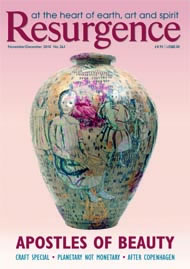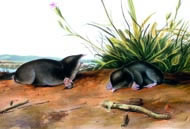In 1908 Kenneth Grahame published his pastoral masterpiece, The Wind in the Willows. The story opens with house-proud Mole struggling with his spring cleaning. He “had been working very hard all the morning, spring-cleaning his little home. First with brooms, then with dusters; then on ladders and steps and chairs, with a brush and a pail of whitewash; till he had dust in his throat and eyes, and splashes of whitewash all over his black fur, and an aching back and weary arms. Spring was moving in the air above and in the earth below and around him, penetrating even his dark and lowly little house with its spirit of divine discontent and longing. It was small wonder, then, that he suddenly flung down his brush on the floor, said ‘Bother!’ and ‘O blow!’ and also ‘Hang spring-cleaning!’ and bolted out of the house without even waiting to put on his coat.”
It is not surprising that this book has had such an enduring success with both adults and children; who could fail to identify with the familiar traits of the animal characters? Grahame’s description seems to capture some essence of the mole, unearthing important aspects that we humans share with them.
Read as a modern-day metaphor, this story shows how precious our Earth and all its creatures are, but for me it is charming Mole who is the hero. His endearing eccentricities portray him as a home-loving, hard-working and deeply recognisable animal. And with wisdom and humour, Grahame shows the importance of any home, however humble: “No one could pretend that Mole End was exactly fashionable. Mole wasn’t rich like Toad, or artistic like Rat, or of ancient lineage like Badger, but he had made his little house himself to suit his own tastes and he was fond of it.” So let’s hear it for unfashionable Mole, for perhaps he embodies the simplicity we crave.
However, on seeing a dead mole pinned to a fence during a country walk one day, it struck me that not everybody shares this sentiment. I know that they dig up our lawns and leave potholes, and a brief internet search proves that although moles helpfully gobble up and recycle hordes of unpopular vegetable and flower-devouring invertebrates in our gardens, nobody has anything positive to say about them. In order to preserve our faultless lawns, we crush poor mole with our use of imperialistic language and words like ‘infestation’ and ‘extermination’.
In truth, very little is known about the mole. Talpa Europea, or ‘mouldywarp’, to use the old common name, can be found across Europe. This intriguing name is derived from Germanic roots: it is ‘Maulwürfe’ in German, ‘muldvarp’ in Norwegian and ‘moldvarpa’ in Icelandic. The mul/mold part of the word means ‘soil’, and ‘varp’ is from a Nordic word for ‘throw’; thus we have ‘one who throws soil’. As one who is currently nurturing a wilder garden, I find this name heart-warmingly subversive, and as 2010 is the International Year of Biodiversity, I suggest, in the spirit of celebration, that the mole should take its place as an emblem of our efforts to understand all of creation in its creeping, crawling, burrowing magnificence.
There are more than 30 species of mole in the world and likely more we have yet to discover. Our mole prefers a soil that is light and humid. It eats earthworms, insects and other invertebrates but, contrary to popular belief, not roots or plants. It lives almost entirely underground in tunnels and chambers and prefers a solitary existence, except at breeding times. And in a beautiful example of natural intelligence, if the mole finds something it doesn’t like in one of its corridors (for example a trap or some poison), it will simply ‘plug up’ the way and build a brand new passage.
Charles Darwin noted that the mole was unusual because it retains organs that are in the process of being phased out by natural selection. Natural selection and genetic variation have combined to produce moles with the vestigial eyes and ears they have today, and these organs are invisible only because they are covered with a membrane of skin and fur. The eyes can in fact detect light, and the ears are extremely sensitive and therein lies one of the solutions if you have a mole issue in your lawn. Moles hate noise and will flee if empty bottles are immersed in the soil with the neck exposed for the wind to whistle over.
If you have ever found a mole, you will know it is covered in dark, velvety fur. (‘Moleskin’ is not, in fact, the product of mole pelts but an attractive synthetic imitation.) Mole fur is highly unusual because of its texture. It has a dense softness that enables moles to move speedily and smoothly through their tunnels; this is because each hair is thicker in the middle and narrower at the end, making it less resistant to surfaces.
Faced with a mountain range of fresh spoil heaps on the lawn or field, some may still not feel that this animal has much appeal, but surely it should be possible to share the Earth with our fellow creatures? Inspired by the presence of moles on their land, the owners of one working farm in West Wales transferred their 40 acres of land entirely back to Nature. Twenty years on, the pioneering farm is now the Shared Earth Trust, run as a thriving wildlife reserve and educational centre.
This wonderful visitor centre was an early showcase for how we could think differently about the way we manage land for wildlife, and today the political establishment has taken on the same idea with the new Futurescapes project. In consultation with a partnership of conservation bodies, experts and government organisations, Futurescapes will expand the limitations of single reserves to encourage and protect wildlife throughout the UK.
The fact is, if we kill our moles, more will soon arrive and occupy the newly vacated territory, and we will have another senseless battle on our hands. Turning to poets and storytellers, the advice is clear: we must lay down our arms and accept that we can find a way to live as part of Nature, rather than making war upon it.
In Native American folklore, Mole brought great wisdom. In a tale entitled The Cracks in the World, Mole was the first to discover cracks in the Earth. He burrowed down and came up with medicine from Mother Earth. Instead of finding something fearful or portentous, he returned with knowledge. With this he was able to advise and heal the other animals, and, if they were willing to listen, teach humankind as well. The Earth-wisdom that Mole brought was passed on to create greater health and harmony between humans and the natural world.
A poem by Czech poet and scientist Miroslav Holub uses the mole as a central metaphor to highlight humankind’s misunderstandings of Nature. In Brief Reflection on Cats Growing in Trees the poet explores misconceptions and disagreements that can occur in science when we perceive only part of the picture. The poem reads as an allegory in which the mole community wishes to discover more about the world above. One mole travels up, only to discover birds in the tree that stands above their home, and returns below ground to claim that birds grow on trees. The moles below are not sure about this and the next mole sent up to find out some more notices the sound of cats mewing. He returns claiming that it is cats that grow on trees. A third and rather ‘neurotic’ mole is suspicious and decides that both moles could be mistaken. After his exploratory foray he declares that “In fact, things above | were the same as below, only the clay was less dense and | the upper roots of the tree were whispering something, | but only a little. | And that was that.”
The irony is clear, with this poet slyly suggesting that, as with the moles’ perceptions in the poem, there may be dimensions in the natural world around us that have gone unnoticed, and hinting that there is yet more that we humans still do not understand.
For more information visit: www.rspb.org.uk/futurescapes







